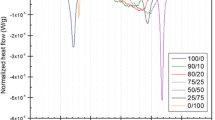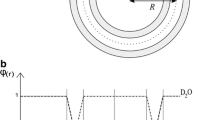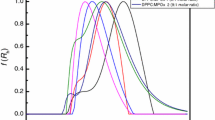Abstract
Dimeric β-cyclodextrins (β-CD) were prepared from the reaction of native β-CD with epichlorohydrin under basic conditions, and the effects on the diacetylene (DA) and polydiacetylene (PDA) liposomes have been investigated. Vesicular DA was solubilized in the presence of dimeric β-CD with the consequent inhibition of polymerization. The result is attributed to the formation of a complex between dimeric β-CD and DA liposomes, and it is clearly differentiated from that of monomeric β-CD. Furthermore, the ordered supramolecular structure of PDA was perturbed by the dimeric β-CD, which was detected from the visible color change. Finally, the morphological characteristics and size of PDA in the absence and presence of dimeric β-CD were examined using transmission electron microscopy and dynamic light scattering The results show fused structure of size more than 200 nm along with the deformation of the vesicles, and they represent a novel phenomenon of liposome structure induced by complexation with dimeric β-CD. The evaluated physicochemical characteristics can be applied to the development of carbohydrate-based detergents.








Similar content being viewed by others

References
Charych, D.H., Naqy, J.O., Spevak, W., Bednarski, M.D.: Direct colorimetric detection of a receptor-ligand interaction by a polymerized bilayer assembly. Science 261, 585–588 (1993)
Ahn, D.J., Kim, J.M.: Fluorogenic polydiacetylene supramolecules: immobilization, micropatterning, and application to label-free chemosensors. Acc. Chem. Res. 41, 805–816 (2008)
Charoenthai, N., Pattanatornchai, T., Wacharasindhu, S., Sukwattanasinitt, M., Traiphol, R.: Roles of head group architecture and side chain length on colorimetric response of polydiacetylene vesicles to temperature, ethanol and pH. J. Colloid Interface Sci. 360, 565–573 (2011)
Olmsted III, J., Strand, M.: Fluorescence of polymerized diacetylene bilayer films. J. Phys. Chem. 87, 4790–4792 (1983)
Charych, D., Cheng, Q., Reichert, A., Kuziemko, G., Stroh, M., Nagy, J.O., Spevak, W., Stevens, R.C.: A ‘litmus test’ for molecular recognition using artificial membranes. Chem. Biol. 3, 113–120 (1996)
Singh, M., Sharma, R., Banerjee, U.C.: Biotechnological applications of cyclodextrins. Biotechnol. Adv. 20, 341–359 (2002)
Easton, C.J., Lincoln, S.F.: Modified cyclodextrins: scaffolds and templates for supramolecular chemistry. Imperial College Press, London (1999)
Liu, Y., Chen, Y.: Cooperative binding and multiple recognition by bridged bis(β-cyclodextrin)s with functional linkers. Acc. Chem. Res. 10, 681–691 (2006)
Wahlström, A., Cukalevski, R., Danielsson, J., Jarvet, J., Onagi, H., Julius Rebek, J., Linse, S., Gräslund, S.: Specific binding of a β-cyclodextrin dimer to the amyloid β peptide modulates the peptide aggregation process. Biochemistry 51, 4280–4289 (2012)
Breslow, R., Chung, S.: Strong binding of ditopic substrates by a doubly linked occlusive C1 clamshell as distinguished from an aversive C2 loveseat cyclodextrin dimer. J. Am. Chem. Soc. 112, 9659–9660 (1990)
De Jong, M.R., Engbersen, J.F., Huskens, J., Reinhoudt, D.N.: Cyclodextrin dimers as receptor molecules for steroid sensors. Chemistry 6, 4034–4040 (2000)
Tabushi, I., Kuroda, Y., Shimokawa, K.: Duplex cyclodextrin. J. Am. Chem. Soc. 101, 1614–1615 (1979)
Kim, J.M., Lee, J.S., Woo, S.Y., Ahn, D.J.: Unique effects of cyclodextrins on the formation and colorimetric transition of polydiacetylene vesicles. Macromol. Chem. Phys. 206, 2299–2306 (2005)
Renard, E., Deratani, A., Volet, G., Sebille, B.: Preparation and characterization of water soluble high molecular weight β-cyclodextrin-epichlorohydrin polymers. Eur. Polym. J. 33, 49–57 (1997)
Li, J., Xiao, H., Li, J., Zhong, Y.: Drug carrier systems based on water-soluble cationic β-cyclodextrin polymers. Int. J. Pharm. 278, 329–342 (2004)
Kuniak, L., Marchessault, R.H.: Study of the crosslinking reaction between epichlorohydrin and starch. Starch Starke 24, 110–116 (1972)
Schneider, H.-J., Hacket, F., Rűdiger, V., Ikeda, H.: NMR studies of cyclodextrins and cyclodextrin complexes. Chem. Rev. 98, 1755–1786 (1998)
Timoszyk, A., Latanowicz, L.: Interactions of sialic acid with phophatidylcholine liposomes studies by 2D NMR spectroscopy. Acta Biochim. Pol. 60, 539–546 (2013)
Nie, X., Wang, G.: Synthesis and self-assembling properties of diacetylene-containing glycolipids. J. Org. Chem. 71, 4734–4741 (2006)
Lee, S., Kim, J.-M.: α-Cyclodextrin: a molecule for testing colorimetric reversibility of polydiacetylene supramolecules. Macromolecules 40, 9202–9204 (2007)
Kolusheva, S., Boyer, L., Jelinek, R.: A colorimetric assay for rapid screening of antimicrobial peptides. Nat. Biotechnol. 18, 225–227 (2000)
Yaroslavov, A.A., Sybachin, A.V., Kesselman, E.J., Talmon, Y., Rizvi, S.A.A., Menger, F.M.: Liposome fusion rates depend upon the conformation of polycation catalysts. J. Am. Chem. Soc. 133, 2881–2883 (2011)
Yaroslavov, A.A., Efimova, A.A., Lobyshev, V.I., Kabanov, V.A.: Reversibility of structural rearrangements in the negative vesicular membrane upon electrostatic adsorption/desorption of the polycation. Biochim. Biophys. Acta-Biomembr. 1560, 14–24 (2002)
Kragh-Hanse, U., Maire, M.I., Møller, J.V.: The mechanism of detergent solubilization of liposoems and protein-containing membranes. Biophys. J. 75, 2932–2946 (1998)
Kozlovsky, Y., Chernomordik, L.V., Kozlov, M.M.: Lipid intermediates in membrane fusion: formation, structure, and decay of hemifusion diaphragm. Biophys. J. 83, 2634–2651 (2002)
Acknowledgments
This work is supported by the National Research Foundation of Korea Grant funded by the Korean Government (NRF-2011-0024008) and supported by the Priority Research Centers Program through the National Research Foundation of Korea (NRF) funded by the Ministry of Education, Science and Technology (2012-0006686). SDG.
Author information
Authors and Affiliations
Corresponding author
Rights and permissions
About this article
Cite this article
Cho, E., Choi, J.M., Jeong, D. et al. Liposome solubilization induced by complexation with dimeric β-cyclodextrin. J Incl Phenom Macrocycl Chem 80, 427–435 (2014). https://doi.org/10.1007/s10847-014-0431-5
Received:
Accepted:
Published:
Issue Date:
DOI: https://doi.org/10.1007/s10847-014-0431-5



